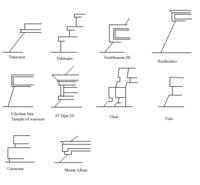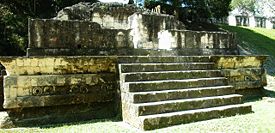
Talud-tablero
Encyclopedia
Talud-tablero is an architectural
style. It consists of a platform structure, or the tablero, on top of an inward-sloping surface or panel, the talud. It may also be referred to as the slope-and-panel style.
Mesoamerica
. It is found in many cities and cultures but is strongly associated with the Teotihuacan
culture of central Mexico
, where it is a dominant architectural style.
The earliest examples of talud-tablero constructions date not from the Teotihuacan period, however, but are found in earlier constructions in the Tlaxcala-Puebla region.
Many different variants on the talud-tablero style arose throughout Mesoamerica, developing and manifesting itself differently among the various cultures. In some cases, such as the Maya
city of Tikal
, the introduction of talud-tablero architecture during the Early Classic
corresponds with direct contact with Teotihuacan and possible domination or conquest. However, the form of contact at other cities is less well documented and presumably included trade and cultural contacts.


Architecture
Architecture is both the process and product of planning, designing and construction. Architectural works, in the material form of buildings, are often perceived as cultural and political symbols and as works of art...
style. It consists of a platform structure, or the tablero, on top of an inward-sloping surface or panel, the talud. It may also be referred to as the slope-and-panel style.
Cultural significance
Talud-tablero is often employed in pyramid construction, found in pre-ColumbianPre-Columbian
The pre-Columbian era incorporates all period subdivisions in the history and prehistory of the Americas before the appearance of significant European influences on the American continents, spanning the time of the original settlement in the Upper Paleolithic period to European colonization during...
Mesoamerica
Mesoamerica
Mesoamerica is a region and culture area in the Americas, extending approximately from central Mexico to Belize, Guatemala, El Salvador, Honduras, Nicaragua, and Costa Rica, within which a number of pre-Columbian societies flourished before the Spanish colonization of the Americas in the 15th and...
. It is found in many cities and cultures but is strongly associated with the Teotihuacan
Teotihuacan
Teotihuacan – also written Teotihuacán, with a Spanish orthographic accent on the last syllable – is an enormous archaeological site in the Basin of Mexico, just 30 miles northeast of Mexico City, containing some of the largest pyramidal structures built in the pre-Columbian Americas...
culture of central Mexico
Mexico
The United Mexican States , commonly known as Mexico , is a federal constitutional republic in North America. It is bordered on the north by the United States; on the south and west by the Pacific Ocean; on the southeast by Guatemala, Belize, and the Caribbean Sea; and on the east by the Gulf of...
, where it is a dominant architectural style.
The earliest examples of talud-tablero constructions date not from the Teotihuacan period, however, but are found in earlier constructions in the Tlaxcala-Puebla region.
Many different variants on the talud-tablero style arose throughout Mesoamerica, developing and manifesting itself differently among the various cultures. In some cases, such as the Maya
Maya civilization
The Maya is a Mesoamerican civilization, noted for the only known fully developed written language of the pre-Columbian Americas, as well as for its art, architecture, and mathematical and astronomical systems. Initially established during the Pre-Classic period The Maya is a Mesoamerican...
city of Tikal
Tikal
Tikal is one of the largest archaeological sites and urban centres of the pre-Columbian Maya civilization. It is located in the archaeological region of the Petén Basin in what is now northern Guatemala...
, the introduction of talud-tablero architecture during the Early Classic
Mesoamerican chronology
Mesoamerican chronology divides the history of pre-Columbian Mesoamerica into several periods: the Paleo-Indian , the Archaic , the Preclassic , the Classic , and the Postclassic...
corresponds with direct contact with Teotihuacan and possible domination or conquest. However, the form of contact at other cities is less well documented and presumably included trade and cultural contacts.


External links
- Definition of Talud-tablero Archeology Wordsmith
- Teotihuacano art and architecture University of Texas
- Locating the Place and Meaning of the Talud-Tablero Architectural Style in the Early Classic Maya Built Environment Doctoral Dissertation by Crtistin Cash

